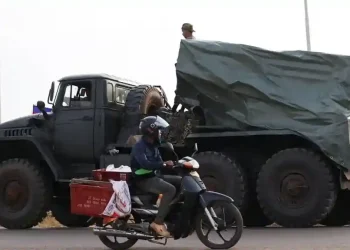Ukraine Unveils ‘Tryzub’: A Laser Weapon That Can Shoot Down Aircraft from Over a Mile Away
Ukraine has announced the development of a laser weapon capable of shooting down aircraft from more than a mile away. The weapon, named Tryzub, was revealed by Vadym Sukharevskyi, the commander of Ukraine’s Unmanned Systems Forces, at a defense summit in Kyiv this week. He shared that the laser can target and destroy aircraft flying at altitudes over 2 kilometers (1.2 miles).
Sukharevskyi confidently stated, “It truly works, it truly exists,” emphasizing that the weapon’s capabilities are actively being enhanced. The name Tryzub, meaning “trident” in Ukrainian, symbolizes the nation’s independence, strength, and unity.
While specific details about the Tryzub system were not provided, experts have suggested that the development of such a weapon is plausible. Patrick Senft, an expert at Armament Research Services, a consultancy focused on armament research, noted that directed-energy weapons (DEWs) like Tryzub are indeed achievable. “It is entirely feasible for Ukraine to develop a functional directed-energy weapon capable of destroying aerial targets,” Senft explained. He pointed out that commercial, off-the-shelf welding lasers, combined with other available technologies, could make this possible, similar to the U.S. Navy’s Laser Weapons System (LaWS), which has been operational since 2014.
How the Tryzub Laser Works and Its Effectiveness Against Drones
Directed-energy weapons like Tryzub are particularly effective against slow, low-flying drones, which are common in Russia’s aerial attacks. These drones are vulnerable to heat due to their fragile components. Senft explained that low-flying UAVs, like the Shahed-136/Geran-2 drones, are especially susceptible to sustained laser exposure due to their steady flight patterns. The weapon can concentrate energy on a specific point, targeting vital components of the drone.
However, Senft also highlighted key limitations of such systems. The speed of the target and the energy loss over distance pose challenges. Fast-moving or heat-resistant targets, such as artillery shells or ballistic missiles, require more advanced systems to neutralize.
Technical Challenges of Deploying Laser Systems
While the Tryzub laser may be effective against drones, Fabien Hoffmann, an expert from the Oslo Nuclear Project (ONP), noted several technical challenges in using lasers against drones or missiles. These challenges include ensuring sufficient laser beam strength, managing the cooling of the system, and dealing with atmospheric conditions like clouds, rain, or thermal blooming. Thermal blooming occurs when the laser beam heats the surrounding air, causing the energy to disperse and reducing its effectiveness.
“To assess how effective it is in a missile defense role, we’ll need to see how it performs in practice,” Hoffmann added.
Global Laser Weapons Development
Ukraine’s Tryzub joins a small group of nations that have developed or are developing laser weapons. The U.S., China, and Israel are known to have operational laser systems, with the UK also working on its own laser system, DragonFire. Set to be operational in 2027, the DragonFire system could potentially be deployed in Ukraine to counter Russian drones, according to former UK Defense Minister Grant Shapps.
As countries around the world continue to explore directed-energy weapons, the successful deployment and effectiveness of Ukraine’s Tryzub laser will be closely monitored as a potential game-changer in modern warfare.
This article was rewritten by JournosNews.com based on verified reporting from trusted sources. The content has been independently reviewed, fact-checked, and edited for accuracy, neutrality, tone, and global readability in accordance with Google News and AdSense standards.
All opinions, quotes, or statements from contributors, experts, or sourced organizations do not necessarily reflect the views of JournosNews.com. JournosNews.com maintains full editorial independence from any external funders, sponsors, or organizations.
Stay informed with JournosNews.com — your trusted source for verified global reporting and in-depth analysis. Follow us on Google News, BlueSky, and X for real-time updates.














